
|   |

|   |
 e-mail: sunilkothari1933@gmail.com Devadasi, Apsara and Chali Nritya seminar at Guwahati Photos: Arup Jyoti Kalita July 15, 2016 Prateesha Suresh, an exponent of Sattriya dance, under the aegis of her Pratishruti Foundation arranged a one day seminar and lecture demonstration / performance at Rabindra Bhawan, Guwahati on 4th July 2016. The seminar on 'Tradition of Classical Dance and Music in Assam' focused on Devadasi Nritya, Apsara Nritya, Chali Nritya and Classicism in Sattra singing. It is a welcome initiative offering insights into these dance and music traditions. In spite of the fact that Sattriya dances received recognition in the year 2000 as the 8th classical dance form, a lot still needs to be brought to the attention of scholars, performers, gurus, organizers and both connoisseurs and lay public alike. Deeply interested in traditions of Sattriya dances, under the guidance of late Dr. Maheswara Neog, I had visited Dhubri where in mid sixties, Nati dances were still existing and with help of my photographer friend, late Subodhchandra, I had got some of those dances photographed and also recorded on 8mm film. But later on the attention was focussed on Sattriya dances and I could not devote more time to study of this near extinct tradition. Prevalent from 7th century, Devadasi tradition in Assam was quite flourishing. Devadasis were attached to temples in many parts of India. Similarly in Assam also they were attached to Shiva, Shakti and Vishnu temples. During the colonial era due to political and social pressures the dance and the dancers suffered and lost patronage and the tradition almost came to an end. However, it was Bishnu Rabha and Pradip Chaliha, in early forties who tried to revive Nati dance. In 1950, one Ratnakar Talukdar, an outsider to the temple Nat Guild, but an artist of considerable repute, came forward to take up the strenuous task of reviving the original dance form against all odds. An expert khol player Besaram Bayan helped him for musical accompaniment. And two exponents by name Raya and Kaushalya helped Talukdar to reconstruct a part of noon time puja dance, from pieces of the half forgotten dance. Talukdar recreated with the help of Bishnu Rabha. However, the costume has undergone a change. The performers wear a white ghaghra, long skirt and long sleeved yellow blouse wrapped with white cloth. They put on marigold flowers in coiffure and also a garland around the neck. It is not conclusively known whether songs accompanied the dance in the past. Kiritnath Bordoloi, an eminent musician, has according to Pradip Chaliha recovered a song from the Devadasi of Dubi a long time back. Specimen songs sung by the Hajo Natis were also available in Brajbuli language. In recent times, young Dilip Kakoti who studied under Ratnakanta Talukdar, is trying to revive the tradition. He is assisted by Girindra Patgiri for khol, and Satyajit Chaudhury helped for taal with small cymbals. Dilip Kakoti gave a brief account of the tradition of Nati/Devadasi dance and presented three young dancers who he has trained in Nati dance. They were Nisha Chaudhury, Vidisha Sharma and Eninjula Boruah. 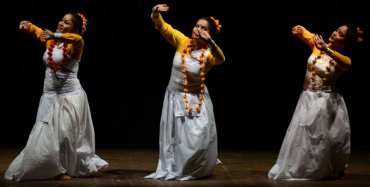
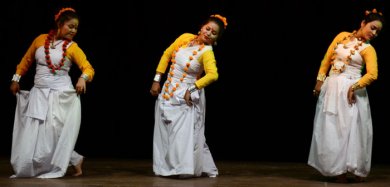
Devadasi dance
Their movements were simple and more of a ritual nature, preparing
themselves putting on clothes after taking bath, looking into mirror,
taking pirouettes, dancing in circle, holding arms with pataka hasta in
front and other at the back, reminiscent of similar movements in Odissi
dance, known in technical parlance as Thiya lon, standing and Athua lon,
bending. They formed a row and bent and danced holding their arms in
front of their face, also held skirts, jumped and moved with slight hip
movements. They also fell on all four bending backward as seen in
Gotipua dancers who perform acrobatic feats. Dr. Maheswara Neog has
observed that Sankaradev had spent considerable time in Puri and had
seen dances of Devadasis (known as Maharis) and he might have
incorporated those movements in Sattriya dances and also Nati
dances. But this cannot be corroborated with specific evidences.It had 12 parts, Bajna, performed in vilambit and drut. Renowned guru Sailen Saikia gave information that training is given in Sangit Vidyalaya at Jorhat, as it is in syllabus. Rinjumani, daughter of late Raseswar Saikia, also said that her father had introduced its training in 1975 in this institution. What we saw was one long number and gave glimpse into one time practice. It was also practised in Sibsagar, Hatkeswar temple and at Hajo. It would be interesting to see what more can be done to revive this tradition. Perhaps if a guru of genius, say Kelucharan Mohapatra was around, it can have creative inputs. For many scholars and dancers this dance tradition remains a relic of the past. Apsara Dance 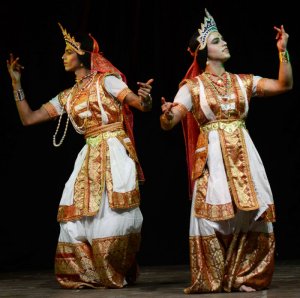
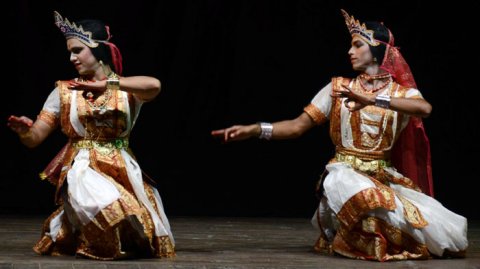
Apsara dance
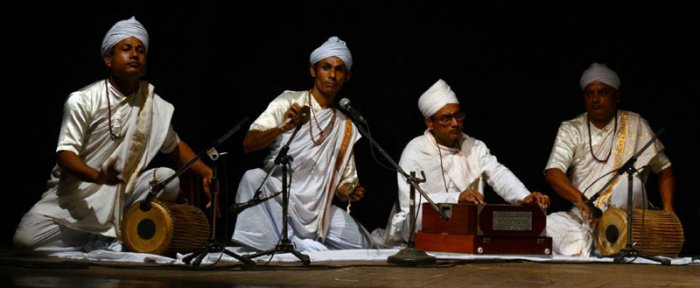 Accompanists for Apsara dance Auniati Sattra on Majuli island was established in 1653 AD by the Ahom King Sultanate. The Ahom King was given the name Jayadhwaja Singh after he adopted the Hindu / Vaishnava religion, from the first Sattradhikar Shri Niranjan Dev of Auniati Sattra. The Apsara dance taught by Damodar Dev, one of the principal disciples of Sankaradev, is still practiced and performed by young Vaishnava boys in the Sattra. It is ritualistically performed to the beats of dholaks on the first day of the Assamese New Year - Bohag Bihu. Dholok is a percussion instrument used only in the Auniati Sattra, where there are idols of Lord Krishna which are placed on the Manikuta before which the dance is performed. In other Sattras, Shrimad Bhagavata is placed but not idols, though I was told that on the various steps leading to the top, various idols are placed but are not generally noticed or worshipped as Sankaradev emphasised ek naam sharan and wanted to bring unity to religion. Apsara Nritya was presented by Vaishnavas of Auniati Sattra. Sattradhikar Pitambar Dev Goswami was felicitated. The participants were Vishnu Bora Bayan, Prasanna Bhuyan Bayan, Putul Bar Gayan, Bipin Saikia, Tulasi Rajkhowa and Gajen Bhuyan. The two male dancers were dressed in costumes of female dancers. They were Jituparna Borthakur and Partha Barua. Apsara Nritya has similarities with Chali Nritya and was specially choreographed for entertaining gods. The distinct feature of the costume was the head crowns (mukuts) the dancers wear and the costume is regal, with large gold brocades at the bottom and also kinkini (waist band). The ornaments contain of khadu bangles and pearl necklaces. The appearance justifies their nomenclature and Apsara dance. The movements are graceful as seen in Chali dances of Sattriya. The dances are performed to the accompaniment of dholok as stated earlier instead of khol and mridang. The number performed was Pravesher Nach followed by Gitor Nach, with a song. No facial expressions are used to express the meaning of the song. Similarity can be seen as in Chali dance in which there is chali with Gitor Nach but no abhinaya is performed. I had not known of this tradition of Apsara Nach. It is being preserved in Auniati Sattra. Chali Nritya  Chali Nritya The presentation was preceded by the Gayan Bayan by the celebrated guru Tankeswar Hazarika Barbayan (khol), with Udoy Dutta (vocal), Siddharth Sarkar (violin) and performed by four young female dancers Priyanuja Kashyap, Pankhipriya Kalita, Rashmi Bora and Priyadarshini Bora. The interesting part was the explanation of Paritala and how through the movements of the body horizontally from right to left and back constitutes a part of the tala. Very graceful, the intricacies which are generally lost on onlookers were brought to the notice of the audience. All the young dancers performed gracefully. These dancers are presented now as a part of the repertoire of a Sattriya program. The costumes consisted of white lehenga, long skirt with a colourful border towards end and black blouse decorated with V shape colourful scarf, kinkini (waist band) and necklaces. Quite attractive and also distinct in contrast to present day colourful costumes of Assamese silk. The co-relation shown among the three dances was interesting. Though it is difficult to stall the innovations introduced by the contemporary dancers, Prateesha feels that the sanctity of the costumes must be maintained in order to represent the tradition. 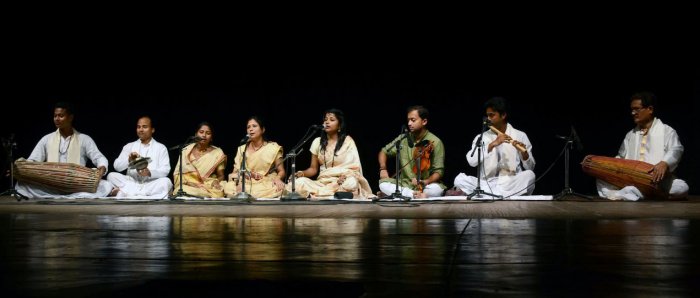 Bargeet The dance demonstration was preceded by a presentation of Dr. Pabitra Pran Goswami to reiterate the classicism in Sattra singing. Bargeet composed by Sankaradev and further followed by Madhavdev are a rich legacy and contain all the elements of classicism. During his lifetime Sankaradev had travelled far and wide leaving his legacy with his disciples which led to the widespread popularity of his creative genius. The classicism of these compositions couldn't be established by one single person due to regional divisions that developed later on. Prateesha feels that it is important that both the musicians from within the Sattras and those from outside the Sattras must pay attention to this important aspect of the art and all concerned in promotion and propagation of Sattra traditions of dance and music see that this aspect is developed properly. I am given to understand that late Raseswar Saikia had initiated the movement for getting recognition of the music of Bargeets as a classical music. The musicians who rendered the Bargeets were Jikumoni Mahant, Sangita Pijari, Nandita Boruah, Jatindra Mahant (khol), Durgeswar Borah (flute), Sanjib Kachari (taal) and Siddharth Sarkar (violin). Prateesha deserves congratulations for mounting this one day seminar, discussion, presentation, performance by different groups, engaging the inmates of Auniati Sattra and Titabar Sattra and a large number of participants. She was ably assisted by Gaurab Dutta, a young Sattriya dancer who is a teacher of Mathematics at Majuli island but is actively involved in performing, studying and teaching. He was an excellent compere and master of ceremony. It was heartening to see someone so young take over such responsibility. 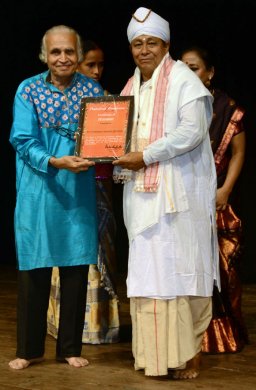 Honoring Tankeswar Hazarika Barbayan of Titabar Sattra 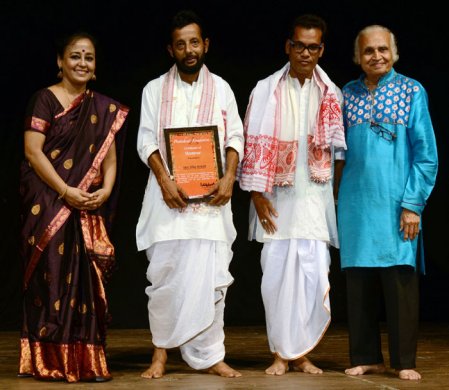 Honouring Dilip Kakoti From left, Prateesha Suresh, Dilip Kakoti, Hari Barbayan and Dr Sunil Kothari It would have been wonderful if the local senior dancers and more gurus had participated and attended to witness this herculean effort to mount the lec-dem, performances and attempt to involve all concerned. I also was given to understand that Pratishruti Foundation had singlehandedly organized this event bringing more than 50 artists including Karuna Bora from Majuli island and Dr. Sanib Borkakoti, Sattradhikar of Auniati Sattra and Sonaram Sharma Burahabokot, Badan Bora Bayan, Krishna Goswami, artists from Gurukul Sattriya Sangit Vidyalaya. These are the traditional and contemporary artists from Sattras and young aspirants devoted to the propagation and preservation of Sattriya dance and music traditions. In particular, the attempts on part of Dilip Kakoti and Hari Barbayan are praiseworthy to revive Nati /Devadasi dance tradition. Shyamhari Chakra, dance critic from Bhubaneswar, in his observations spoke eloquently about the Mahari tradition of Devadasis attached to temple of Jagannath at Puri, attempts of Swapnasundari in propagating reconstruction of Vilasini Natyam performing at a temple at Hyderabad, the issue of Odissi music seeking status of classical music on par with two major musical traditions of Hindustani and Carnatic, similar issues of Bargeet and Assamese music seeking status as classical music, need for similar seminars in other parts of India, including Mumbai, Kolkata, Delhi, Bangalore, Bhubaneswar and Chennai. As Sattriya dances are now well known in these cities, such additional information on Nati / Devadasi dances, Apsara dances, Chali dances and Bargeet music deserve to be widespread and known besides Assam in other parts of India. For such work, Pratishruti Foundation needs to take financial and other support from national institutions like Central Sangeet Natak Akademi, Dept of Culture, Govt of India, local Assamese institutions to get involvement of other agencies. It is most important that community of Sattriya dancers and exponents must get together to resolve many issues.  Dr. Sunil Kothari is a dance historian, scholar, author and critic. He is honored with Padma Shri, Sangeet Natak Akademi award and Senior Critic Award from Dance Critics Association, NYC. Post your comments Please provide your name and email id when you use the Anonymous profile in the blog to post a comment. All appropriate comments posted with name & email id in the blog will also be featured in the site. |